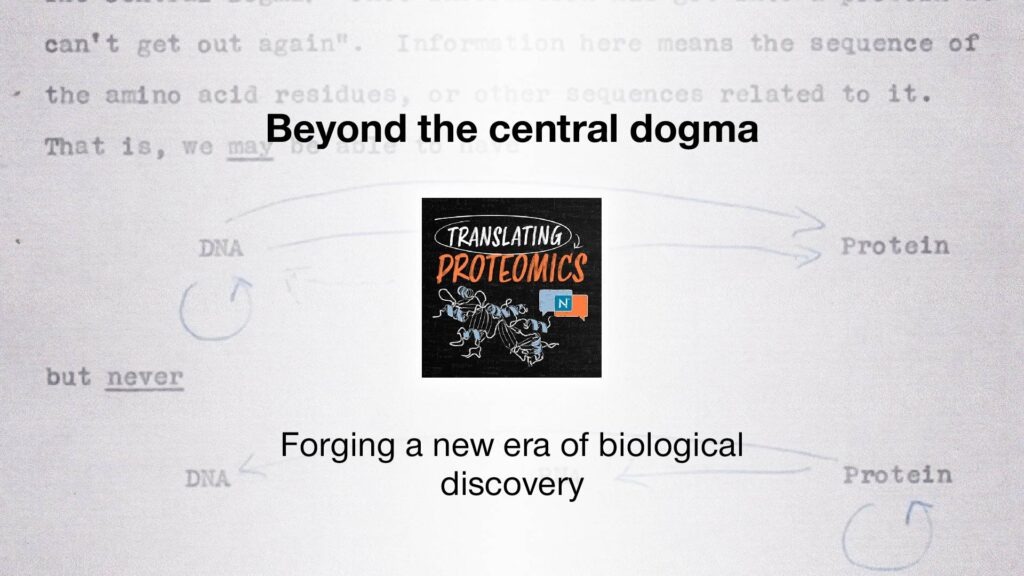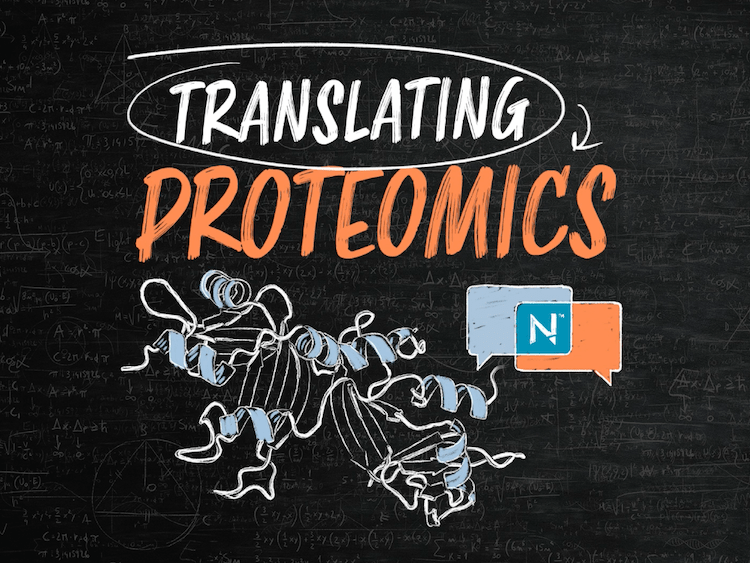
Beyond the central dogma – Forging a new era of biological discovery
Nautilus Biotechnology
October 15, 2024

The central dogma of biology reigns supreme in our understanding of life’s molecular machinery. For decades, textbooks have used the central dogma of biology to describe the linear flow of genetic information from DNA to RNA to protein. But what if this foundational concept is leading us astray?
In a recent episode of our podcast, “Translating Proteomics,” Nautilus Co-Founder Parag Mallick and Senior Director of Scientific Affairs Andreas Huhmer promote a more nuanced understanding of biology’s complexity than that enshrined in the central dogma. Their reasoning? Recent genomics and proteomics discoveries are underlining what’s been clear for some time: biological systems rely on complex control and feedback loops rather than a uni-directional flow of information.
Parag and Andreas argue that a few key advances can help us be less dogmatic about biology’s central dogma, including novel tools that embrace biological complexity and enable us to define core principles. It’s not just an academic exercise — relying on an overly simplistic view of biology is holding back advancements in basic research, medicine, and more, they say.
What is the central dogma of biology?
The central dogma of biology was introduced in a presentation by molecular biologist Francis Crick in 1957 and then formalized in a 1958 paper titled “On protein synthesis.”
As Crick put it:
The Central Dogma
This states that once ‘information’ has passed into protein it cannot get out again. In more detail, the transfer of information from nucleic acid to nucleic acid, or from nucleic acid to protein may be possible, but transfer from protein to protein, or from protein to nucleic acid is impossible.
The concept has been a staple of the biology curriculum for generations and is often used to suggest that all biological information moves unerringly through a rigid series of steps. It’s also often taken to imply that the abundance of RNA corresponds to protein abundance, though it actually says nothing of the sort.
“The arrow goes from the DNA on the left side to the protein or metabolite on the right side,” Andreas says. “And it’s presented as a logical diagram in a way that is obviously not true.”
That’s also not what Crick was trying to say, Parag adds. Instead, Crick was focused on where proteins come from.
Many people interpret the central dogma as an explanation of biological regulation, but Crick’s original intent was far narrower, Parag says. “Really, the central dogma describes the biochemical relationships between biomolecules and not the regulatory relationships under the hood of how cells work.”
And, at the time Crick proposed the central dogma, Parag adds, many critical components of cellular machinery, like messenger RNA (mRNA), hadn’t even been discovered. Indeed, Crick revisited his theory in a 1970 commentary, taking pains to explain that he had never intended the central dogma to be all-encompassing (and also separately stated that he didn’t know the precise definition of the word “dogma” at the time he coined the phrase).
Watch Parag and Andreas discuss what the central dogma actually says:
Why the central dogma of biology is an oversimplification
While the central dogma of biology isn’t necessarily wrong, it overlooks the complex regulatory mechanisms and feedback loops that govern cellular function.
“When we look at the flow of biological information, it’s true that DNA makes RNA, and RNA makes protein,” Parag says. “But this pathway doesn’t help us predict what happens when the system is perturbed by genetic mutations, environmental changes, or disease.”
Andreas agrees. “The central dogma might be useful in describing biochemical relationships, but it falls short in explaining the dynamism of biology,” he says. The framework assumes a deterministic model for biology when, in reality, biological systems are adaptive and probabilistic, and very difficult to predict. For example, the assumption that protein levels should perfectly correlate to their corresponding RNA often falls apart inside cells due to things like RNA degradation and the rate of protein translation.
There are also instances where biological information flows “backward” along the path described by the central dogma. Histone proteins, for example, regulate DNA transcription, effectively feeding back from proteins to genes.
That kind of nuanced understanding of how regulatory processes affect protein levels is a necessity for moving biology to a point where we can begin to make predictions about what will happen, Parag says.
“Ultimately, we want to predict the effects of genetic mutations, environmental exposures, and other changes in biological pathways,” he says.
That goal requires a more comprehensive model that goes beyond the linearity of the central dogma of biology, incorporating the layers of regulation and feedback that characterize living systems.
Watch Parag and Andreas discuss the importance of regulation and control in biology:
Beyond the central dogma toward a general theory of biology
Advancing our understanding of biology necessitates a shift from the simplistic central dogma to a more thorough model.
“I think we don’t have a general theory of biology,” Andreas says. He contrasts the field to physics, where a central theory of the physical world describes every interaction between molecules (though it may not be complete).
Better tools are key to providing those missing data points. Andreas says many scientists acknowledge that the central dogma is simplistic but say it’s too hard to make the measurements necessary to move past it with today’s protein analysis tools.
“A western blot simply cannot capture the dynamic [nature] of a protein. It’s just not possible,” he says. Next-generation technologies that offer total access to the proteome with high sensitivity under different conditions and at multiple time points are required to gather the massive number of data points necessary to advance our understanding of biology.
Watch Parag and Andreas discuss the need for new models in biology:
The role of new proteomics tools in advancing biology
Emerging technologies, such as the NautilusTM Proteome Analysis Platform, aim to deliver the sensitivity, depth, and breadth of analysis needed to transcend biology’s central dogma. These tools are designed to measure low-abundance proteins and track their changes over time, offering insights into the complex interplay between DNA, RNA, and proteins.
Parag also emphasizes the need for a more integrated approach to biological research. “We need a new model that describes not just how biomolecules get created from each other but how cells work,” he says. This involves leveraging advanced computational tools and collaborative efforts to synthesize data from multiple sources and time points.
Conclusion
Revisiting and revising our understanding of the central dogma is crucial for the future of biological research. By developing and utilizing new tools that offer comprehensive proteomic analysis, scientists can build more accurate models of biological systems that capture their many complex interactions. These advancements will pave the way for significant drug development, disease diagnosis, and personalized medicine breakthroughs.
The journey to move beyond the central dogma of biology is challenging but essential. With cutting-edge technologies and a commitment to understanding the true complexity of biology, we can move past the limitations of outdated models and achieve a deeper, more nuanced understanding of life.
MORE ARTICLES

